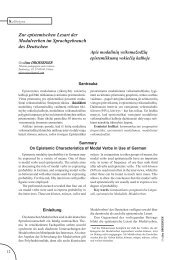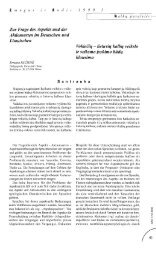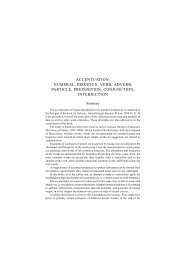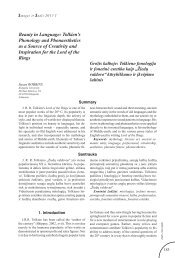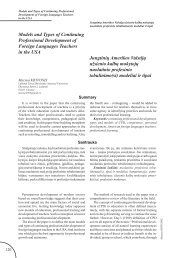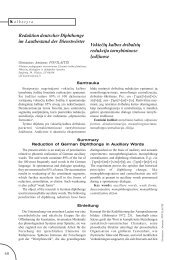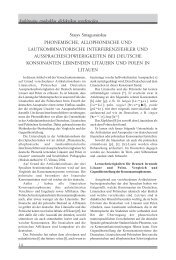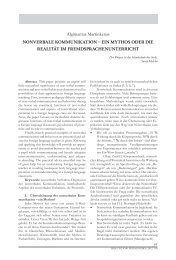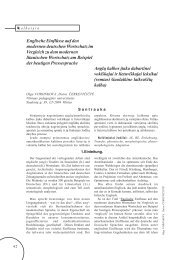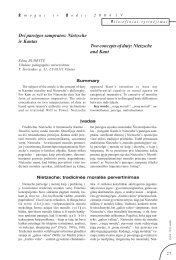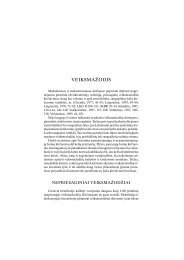Arūnas Diškus - VPU biblioteka - Vilniaus pedagoginis universitetas
Arūnas Diškus - VPU biblioteka - Vilniaus pedagoginis universitetas
Arūnas Diškus - VPU biblioteka - Vilniaus pedagoginis universitetas
You also want an ePaper? Increase the reach of your titles
YUMPU automatically turns print PDFs into web optimized ePapers that Google loves.
In Central Asia, 90 nepticulid species were recognized; in total, the<br />
endemism of the Central Asiatic Nepticulidae fauna is very high (71%)<br />
and about half (53%) the Central Asiatic species with a known host-plant<br />
are trophically associated with Rosaceae.<br />
Study of material collected from Oman and the Indian subcontinent yielded<br />
34 species of Nepticulidae (including twelve new to science).<br />
In total, 105 species of Nepticulidae are reviewed for East Asia (63 of them<br />
were recorded only from the eastern part of the Mandshurian region,<br />
with one species as new to science and 15 species distributed from Europe<br />
to the Mandshurian region.<br />
Study of Neotropical material (74 earlier recorded species and 16 new)<br />
has shown a high level of endemism of the Nepticulidae fauna in general,<br />
and also demonstrated the phenomenon of Acalyptris predomination.<br />
Ten species of Tischeriidae (including 9 new ones) are now known from<br />
southern Africa, i. e., the same number as from Europe with a two hundred<br />
year history of investigation; the southern African tischeriids are associated<br />
with host-plants of at least of 4 families and 6 genera: Rhamnaceae (Scutia),<br />
Tiliaceae (Grewia, Sparmannia, Triumfeta), Anacardiaceae (Rhus) and<br />
Combretaceae (Terminalia).<br />
New data and revision of all published records confirmed 1027 species of<br />
Nepticuloidea & Tischerioidea currently recognized for the world fauna;<br />
most of them, 780 species, belong to the Nepticulidae, 130 to the<br />
Opostegidae 117 to the Tischeriidae. In the Neotropical region the<br />
nepticulid genus Acalyptris predominates (accounting for up to 50% of the<br />
nepticulid fauna); Stigmella is the dominant nepticulid genus in most<br />
geographical regions and in non-tropical areas of the Neotropical region.<br />
The world Nepticuloidea & Tischerioidea are trophically associated with<br />
66 plant families: most species occur on Rosaceae (123 species) and<br />
Fagaceae (93 species); to a lesser extent, but still widely utilised, are such<br />
families as: Rhamnaceae (32 species), Asteraceae (31 species), Fabaceae<br />
(31 species), Salicaceae (28 species) and Betulaceae (27 species).<br />
In the light of host-plant data, the evolution of the Nepticuloidea or Tischerioidea<br />
probably occurred by way of trophic adaptation to 7 plant subclasses from the 12<br />
recognized; four of these host-plant subclasses are common to all three studied<br />
moth families: Hamamelididae, Dilleniidae, Rosidae and Lamiidae.<br />
Three main lineages of generic rank can be recognized within Tischeriidae.<br />
The first (Tischeria) may be the best characterized by the development of a<br />
juxta in the male genitalia, and an antrum in the female genitalia; the<br />
second (Astrotischeria) by the development of a dorsal lobe to the valva, the<br />
uncus overlaid dorsally by lobes of the pseuduncus, utilization of new<br />
host-plant families (particularly Asteraceae), and the third (Coptotriche)<br />
by the development of transtilla, spines on the diaphragma, a ‘tulip-shaped’<br />
aedeagus and by the great enlargement of the membranous half of the<br />
ductus spermathecae in the female genitalia.<br />
35



